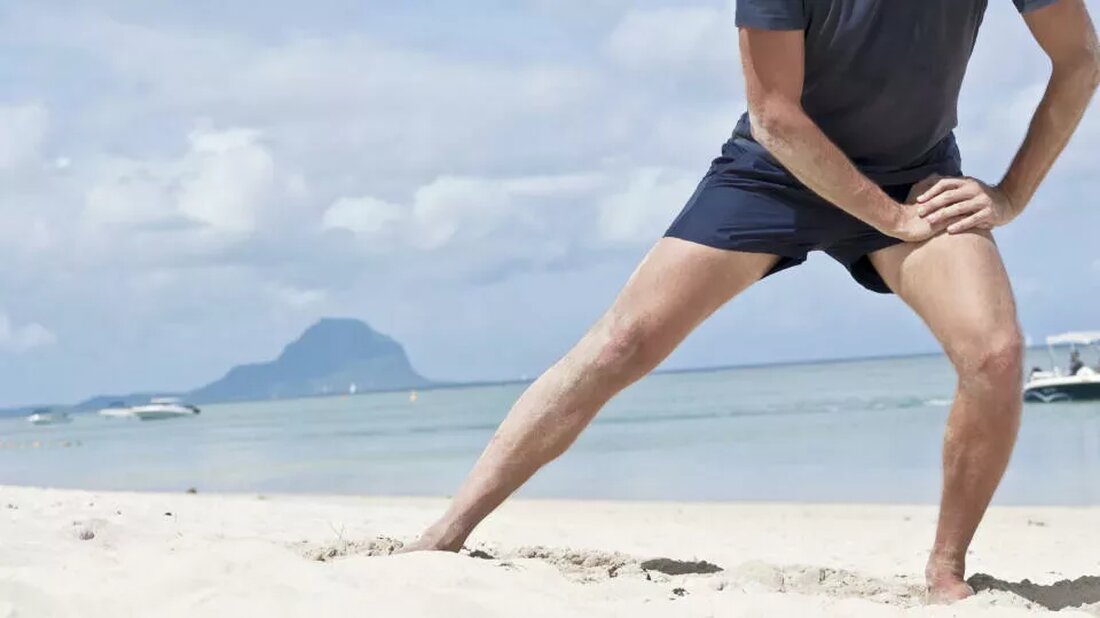Natural remedies for sore muscles and joint pain
Almost everyone experiences muscle or joint problems at some point in their life. The entire human body contains muscles and joints that are constantly in motion, so discomfort can occur at any time and anywhere. The most common type of muscle problem affects the back; An estimated 80% of the adult population in Germany has this condition. This is one of the main reasons people see a doctor. (Source) Muscle pain can affect ligaments, tendons and fascia. A ligament is the fibrous collagen tissue that connects bones to other bones. A tendon is an inelastic band of collagen that connects muscle to bone. Fascia is dense connective tissue that connects muscles, bones and organs. (Source…

Natural remedies for sore muscles and joint pain
Almost everyone experiences muscle or joint problems at some point in their life. The entire human body contains muscles and joints that are constantly in motion, so discomfort can occur at any time and anywhere. The most common type of muscle problem affects the back; An estimated 80% of the adult population in Germany has this condition. This is one of the main reasons people see a doctor. (Source)
Muscle pain can affect ligaments, tendons and fascia. A ligament is the fibrous collagen tissue that connects bones to other bones. A tendon is an inelastic band of collagen that connects muscle to bone. Fascia is dense connective tissue that connects muscles, bones and organs. (Source 1, Source 2)
Why do muscles get sore?
Muscle soreness can occur for various reasons. Exercise is one of the most common. Other factors such as stress can cause a stiff jaw, neck, or pain elsewhere on the body. Twisting, bending or straining can also cause muscle soreness. (Source1, Source 2, Source 3)
Certain diseases and conditions such as fibromyalgia, infections, flu, Lyme disease, polio and lupus can cause muscle soreness. Car accidents are a significant cause of injury, usually to the neck muscles. Almost 2.5 million people are injured or disabled in traffic accidents every year! Dehydration can cause electrolyte imbalances due to low potassium, calcium, or magnesium levels, leading to muscle cramps and discomfort. (Source 1, Source 2)
Top remedies for sore muscles and joints
Stiff, aching muscles are a literal pain, but relief is possible and doesn't have to come in the form of a pill. Here we look at some of the best natural remedies for muscle and joint pain.
1. Inversion therapy
Inversion therapy involves hanging upside down on an inversion table to relieve pressure on the nerve and discs in your spine by increasing the distance between the vertebrae. A variety of studies have confirmed the health benefits of inversion therapy. (Source 1, Source 2)
2. Yoga
Yoga is a mind and body practice that originated in India. It involves practicing various postures, breathing techniques, meditation, and relaxation. According to the National Institutes of Health, a weekly yoga class can help reduce back pain. It's no wonder why yoga is becoming increasingly popular. (Source 1, Source 2)
3. Stretching
Like yoga, stretching is incredibly effective for supporting muscle and joint health. One study found that a stretching class was even more effective than a yoga class in relieving lower back discomfort. Stretching can increase the range of motion of a joint. Stretches of 15 to 30 seconds have the most positive effect on the joints. Interestingly, stretching before exercise increases flexibility but decreases muscle strength. Overall, stretching is an effective way to relieve muscle soreness, even in patients with fibromyalgia or other conditions. (Source 1, Source 2, Source 3, Source 4)
4. Ice and heat
People always want to know whether it is better to treat injuries and sore muscles with heat or cold. There are a few options and reasons to use one of these therapies. Muscle discomfort resulting from exercise or injury has seen more benefit from an ice pack or cold water immersion. When using an ice compress, this pack is typically applied for 20 minutes, four to six times daily for the first 24 to 72 hours. Subsequent heating is sometimes used to relieve discomfort. Many athletes immerse themselves in cold water for a period of time or use a technique called contrast water therapy, where they go back and forth between hot and cold baths to promote blood circulation. Finally, a review of the limited studies found evidence that heat packs definitely help lower back problems because the tension is usually deep in the tissue and muscle tension in the back can be increased with ice treatments. (Source 1, Source 2)
5. Topical muscle and joint relief
There are many over-the-counter lotions and creams that help reduce muscle and joint discomfort. People, including athletes, often use creams and ointments for mild muscle pain. Most of these products only provide temporary relief and do not address the root cause. (Source)
6. Massage
Physiologically, massages relax the muscles and increase blood and lymphatic circulation. A review of many studies found that massage relieves or reduces post-exercise muscle soreness (DOMS). If muscle tension or discomfort occurs, you have the option of going to a massage therapist or you can simply do it yourself. Getting a massage yourself is always a great way to relieve pain and tension in the body parts you can reach in the minute you need. A self-message gives you control over how much pressure you put on your muscles and for how long. A massage stick or roller can work wonders. Massage also increases the hormone oxytocin and lowers levels of cortisol and adrenocorticotropin - hormones produced during stress. This means that massage relieves stress-related muscle tension. (Source 1, Source 2, Source 3)
7. Epsom salt
Epsom salt, which contains magnesium sulfate, is typically used for hot soaks in the bathtub. There aren't many scientific studies on how effective Epsom salt is for relieving muscle soreness. A review found only four studies, three in pregnant women and one in elderly patients. Epsom salt helped relieve muscle soreness in older adults, but half of the studies in pregnant women showed a positive effect while the others found no effect. Regardless, soaking in a hot bath can relax muscles. (Source 1, Source 2, Source 3)
8. Natural Supplements
Science has suggested that various supplements ranging from vitamins to herbs relieve muscle soreness.
Omega-3 fatty acids
Omega-3 fatty acids are the most popular dietary supplement in the US - and for good reason. These fatty acids are found in fish oil as well as plant-based options such as flaxseed or algae oils. Scientific studies found that people with non-surgical neck and back problems who were given 1200 to 2400 mg of omega-3 essential fatty acids per day showed a 60% reduction in symptoms, 80% were satisfied with the results. Even more surprising, however, was that 59% were able to avoid using prescription medications because of the omega-3 supplement. (Source 1, Source 2)
turmeric
The curcumin compound in the root turmeric ( Curcuma longa ) has many health benefits, including relieving muscle soreness. Both Ayurvedic and Chinese medicines have used turmeric for centuries to soothe irritation and loosen stiff joints, among other things. It has powerful antioxidant properties and regulates enzymes in the body. Turmeric is a safe and effective substance for muscle soreness with few side effects. Because it works similarly to NSAIDs, it can interact with them. Therefore, taking turmeric may also cause you to take fewer over-the-counter medications. (Source)
Capsaicin
Capsaicin (8-methyl-N-vanillyl-6-nonenamide) comes from chili peppers ( Capsicum spp.). The substance is known to cause regional anesthesia, meaning it can relieve pain and irritation when applied topically. It is also taken internally in capsules to relieve joint, muscle and nerve pain. (Source)
Vitamin D
Some research has linked low vitamin D levels to muscle and joint pain. Studies have shown that vitamin D has an anti-irritant effect and can reduce skeletal muscle complaints. When the body is low in vitamin D, the T cells of the immune system cause the body to produce redness and painful tissues. With sufficient intake of vitamin D, the compound inhibits T cells and thus reduces pain. (Source)
What about sprains and strains?
A sprain is a stretched or torn ligament. Remember, a ligament is a fibrous connective tissue that attaches bone to bone. According to the American Orthopedic Foot and Ankle Society (AOFAS), up to 25,000 people sprain an ankle every day. This adds up to nearly 10 million sprained ankles every year! (Source 1, Source 2)
Remedies for sprains and strains include rest, ice, compression, elevation and physical therapy. (Source)
This way you avoid muscle and joint problems
Warming up and stretching before and after exercise is extremely important. Sit and stand with good posture. Stretch a few times a week. Stay active. And if you're overweight, losing weight can reduce the strain on your back. (Source)
Drink plenty of fluids before, during and after exercise. If your job requires sitting in the same position most of the day, try stretching or walking several times throughout the day (at least once an hour). Finally, you should maintain good form and posture when lifting heavy objects. Your legs should do most of the work. (Source)
If your symptoms are severe or last longer than seems reasonably tolerable, contact your doctor.

 Suche
Suche
 Mein Konto
Mein Konto
